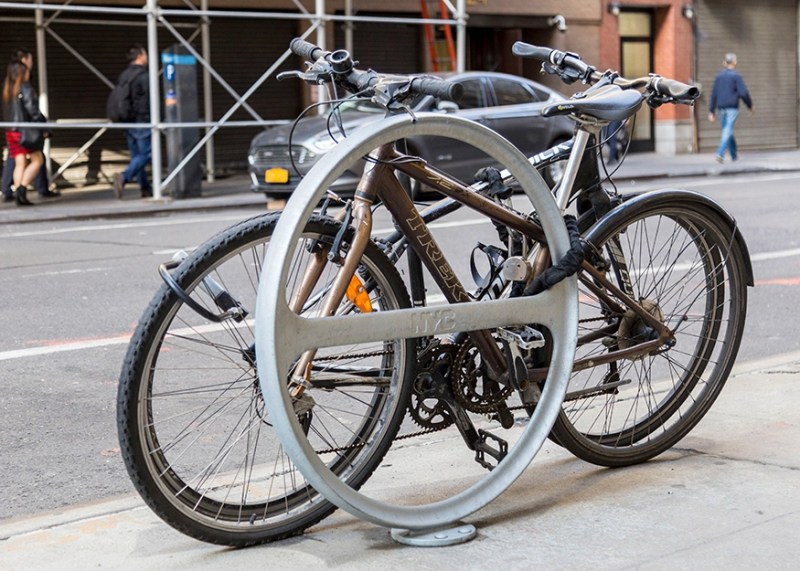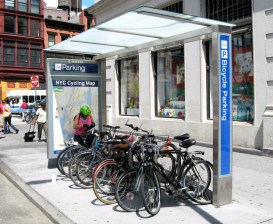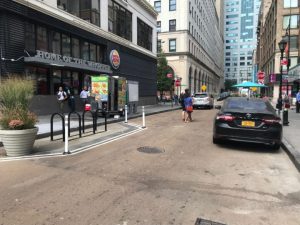RRRGH: Rust Ruins Rack Rollout; Riders Are Roiled

The city had to scale back its efforts to add thousands of new bike parking spaces last year after officials discovered rust on recently installed racks, Streetsblog has learned.
The defect corroded the Department of Transportation’s two most common kinds of bicycle parking, installed over the last two years, prompting officials to pause expansion of those metal hoops and pivot to adding on other rack types — of which there are far fewer.
DOT logged just 334 new bike parking spaces over the first four months of Fiscal Year 2023, or July through October 2022, down from 2,706 the same time in 2021, according to the latest stats in the Preliminary Mayor’s Management Report, a 408-page document that is a preview of the city’s legally required annual report card.
The 88-percent dip year-over-year yielded a rate of just 84 new bike spaces per month — well below monthly averages over the last six fiscal years and a drop in the bucket of the city’s more than 30,000 bike spots.
The setback came while the DOT fell short of former Mayor Bill de Blasio’s promise to install 10,000 new racks over two years by the end of 2022, instead setting up 6,300.
DOT spokesman Vin Barone said there was an issue with the racks’ protective finish, which affected their durability, though he said that racks that are currently on the street are safe for use.
The agency’s contractor, New Jersey-based firm General Foundries, is replacing the faulty racks at no cost to the city.
“New racks with coating issue addressed have started arriving,” the firm’s vice president Ajay Narang wrote in an email.
DOT found the rust on its large hoop and small hoop bike racks, which together account for nearly two-thirds of all bike storage infrastructure.
The bigger hoops, 34 percent of all bike lockups in the five boroughs, are circles with a bar bisecting them. The city began rolling them out after the model won a design competition in 2008.
Small hoops make up 30 percent of racks and they are a circle mounted on poles of former parking meters, which the city started repurposing after launching digital meters in the late 2000s.
DOT in June tapped General Foundries to make and deliver 15,000 large hoop, small hoop, and corrals for $3.2 million.
The agency has been gearing up its bike rack installation in recent years after a lull for most of the de Blasio administration, but the supply snag dropped the agency’s rate to its lowest in at least six years.
The program didn’t meet its 5,000/year goal, but we’ll take the life breathed back into bike parking as a win. The big question is where the city’s bike parking efforts go from here pic.twitter.com/rHjxGmc5QM
— Bike New York (@bikenewyork) December 28, 2022
DOT added 7,442 bike parking spaces in the most recent full Fiscal Year 2022, up 71 percent from 4,350 in FY21, and nearly six times as much as the 1,250 new spaces in FY 20, the lowest since at least FY17, according to recent mayor’s management reports.
During that low point in FY20, the rate was still slightly above the most recent figures, however, at 104 more spaces per month.
Barone didn’t specify how long the hoop racks have been on hiatus, but emphasized that the agency’s most recent full-year numbers were still up from before.
“DOT met its commitment to daylight 100 intersections with bike corrals in 2022, completing more than 10 times as many intersections as in 2020, while significantly ramping up the installation of hoop racks across the city, with more than twice as many installed this year as in 2019,” Barone said. “We are working closely with our contractor to remediate this manufacturing issue and will continue to expand bike parking to support the cycling growth we’ve seen in the city.”
Advocates said they were glad DOT spotted the defect in time to make sure the racks will last.
“We’re glad DOT caught the fault in recent bike racks – they should last a long time, so ensuring quality is more important than hitting a calendar-year number,” said Jon Orcutt, the advocacy director of Bike New York.
DOT missed several of its targets under the Adams administration, including legally required benchmarks for new bus and bike lanes, due to politicians opposed to the changes lobbying against them and amid staffing shortages at the agency.

